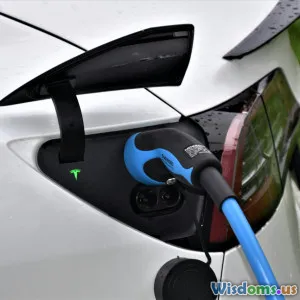
The Future of Automotive Safety
8 min read Explore the exciting advancements and future directions in automotive safety technologies. (0 Reviews)
The Future of Automotive Safety
The automotive industry is on the brink of a transformation driven by groundbreaking advancements in technology. This evolution primarily focuses on the safety of vehicles and the prevention of accidents. With the integration of sophisticated systems, artificial intelligence (AI), and connectivity among vehicles, safety is evolving beyond mere compliance with regulations to proactively ensuring the well-being of drivers and passengers.
The Rise of Advanced Driver-Assistance Systems (ADAS)
What Are ADAS?
Advanced Driver-Assistance Systems (ADAS) refer to a collection of technologies designed to automate and enhance vehicles' safety features. They encompass lane departure warnings, adaptive cruise control, automatic emergency braking, and blind-spot detection. These systems are becoming increasingly sophisticated, with manufacturers adding layers of intelligence to improve performance.
Real-World Examples of ADAS
Manufacturers such as Tesla, Ford, and General Motors are already implementing ADAS into their vehicles. For instance, the Tesla Model S features a system called Autopilot, which can navigate, change lanes, and even park the car autonomously in certain conditions. According to Tesla, vehicles equipped with Autopilot are statistically safer than those without it. In their 2021 report, the company claimed that Tesla vehicles that have Autopilot engaged have 10 times fewer accidents than the average vehicle.
Data Supporting ADAS Effectiveness
A study by the AAA Foundation for Traffic Safety highlights that vehicles equipped with front-crash prevention systems can reduce the number of crashes by up to 40%. Furthermore, highway fatalities have significantly decreased due to lane-keeping assistance systems guiding drivers back into their lanes when signs of drift are detected.
The Role of AI in Enhancing Automotive Safety
AI: A Game Changer for Predictive Safety
Artificial Intelligence plays a pivotal role in the future of automotive safety. Algorithms can analyze data from numerous sources — including sensors, cameras, and external databases — helping vehicles better understand their surroundings. With machine learning, these systems improve over time, adjusting parameters based on past driving behaviors and enhancing safety features.
Case Study: Waymo's Autonomous Vehicles
Waymo, a leader in autonomous driving technology, has developed vehicles capable of navigating complex environments independently. The company reports that its fully autonomous fleet has driven millions of miles, continuously mapping the dynamics of its environments. By obtaining insights from miles of real-world driving experience, AI enhances the decision-making capabilities of vehicles, drastically reducing human error, which is a leading cause of accidents.
Enhanced Data on Driver Behavior
AI technologies capture driver behavior patterns and correlate them with potential safety hazards. For example, insurance firms like Progressive utilize telematics data to provide personalized premiums based on the driver’s safety habits, encouraging safer driving behaviors. This data use nudges drivers towards improved practices, ultimately furthering road safety.
Connected Vehicles: The Next Frontier
Defining Connected Vehicles
Connected vehicles communicate with other vehicles, infrastructure, and cloud-based services through advanced telematics and extensive networking capabilities. This constant flow of information allows for real-time updates that can alert drivers to potential hazards ahead.
Vehicle-to-Everything (V2X) Communication
Emerging V2X technology allows cars to communicate not only with each other but also with the road, traffic signals, and pedestrians. For example, Audi has piloted V2X systems that can send alerts to drivers when a vehicle is approaching an intersection notoriously known for accidents, prompting precautionary actions.
The Impact of 5G on Connected Vehicle Safety
The upcoming 5G networks will supercharge connected vehicle capabilities. With its low latency and high data rates, 5G will enable vehicles to communicate near-instantaneously with each other and their environments. This interplay can lead to the prevention of collisions and enhance navigation and traffic management, making roads safer.
Regulatory Evolution and Standardization
The Need for Regulations
As automotive technologies evolve, so too does the need for a comprehensive regulatory framework governing safety standards. The role of regulatory agencies, like the National Highway Traffic Safety Administration (NHTSA), is becoming critical in ensuring that all technological advancements conform to strict safety evaluations.
Emerging Guidelines for ADAS and Autonomous Vehicles
Various governments are developing guidelines and frameworks that address how autonomous vehicles can operate legally on public roads. In 2021, for example, the NHTSA updated its policy for self-driving car developers, outlining a clear path for testing and deploying such vehicles safely. Harmonizing regulations will facilitate worldwide cooperation, producing uniform safety standards critical for maintaining public trust in these technologies.
The Road Ahead: Challenges and Opportunities
Navigating Challenges in the Journey Towards Safety
While advancements are accelerating, challenges remain. Data privacy issues, cybersecurity threats, and the unpredictability of human behavior present obstacles to fully realizing the potential of automotive safety technologies. Evolving social norms surrounding safety and privacy will necessitate an adaptable legal framework.
Conclusion: A Promising Future Awaits
The future of automotive safety is not just a technological enhancement but a multifaceted approach blending innovation, regulatory oversight, dedicated research, and user education. The integration of ADAS, AI, and connectivity will likely lead to a safer road for everyone. The anticipated rollout of fully autonomous vehicles isn’t just an exhilarating prospect; it promises a future where accidents can be drastically minimized, making driving not just a necessity but a secure and stress-free activity. As we stand at this pivotal intersection of technology and mobility philosophy, one can only wonder: How far can we go to ensure every journey is a safe one?
Rate the Post
User Reviews
Popular Posts
















